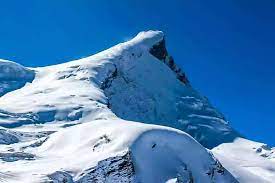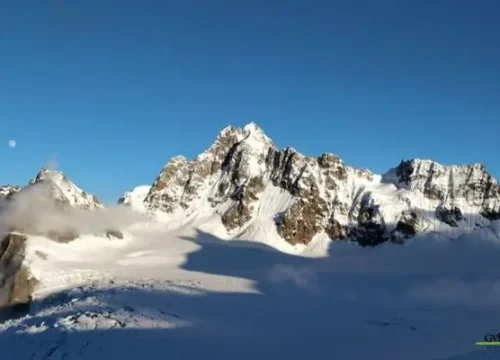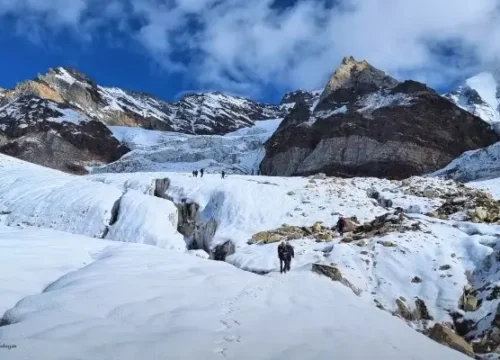Black Peak Expedition the most popular Expedition in Himalayas INDIA
- Upcoming group fixed departures to BLACK PEAK EXPEDITION 2025-26 starting on
- MAY 2025 -: 7th, 25rd
- JUNE-: 3rd , 15th
- SEP -: 6, 17,
- from EX. Dehradun. and every saturday and sunday fixed departure
- Private/customised treks for your own group/family is open as per your preferred date.
Cost Includes
- Transport facility from Dehradun to Dehradun
- Forest Permit and entrance fee including camping charges
- Accommodation in Hotel; Gangotri
- Accommodation in tents on twin share basis
- All meals: breakfast, packed lunch, tea, coffee, snacks, soup and dinner
- Expertise Trek Leader, fluent in English and Hindi certified in basic and advance, Search & Rescue , Method of Instructions mountaineering courses from NIM, IMF or Hanifl Centre outdoor Education
- Experienced local guide and Sherpa, permanent technical guide
- Kitchen team
- Porters
- Helpers
- High quality camping tents, sleeping bags, mattress liner etc
- Dining Tent
- Helmet,
- Gaiters, Koflach Climbing shoes
- Crampons
- Ice Axe, Screw gate
- Carabineers, rock pitons, ice pitons, snow stakes
- Rescue Ropes, Climbing Ropes, Snow bar
- Harness, Descended, Ascender, figure of 8, Ice Screw
- Radio Willkie Talkie for Communication
- Medical Kit
- Oxygen Cylinders
Cost Excludes
-
16D / 15N
-
6,387 meters
-
Hard
BLACK PEAK EXPEDITION
Black Peak Expedition the most popular Expedition in Himalayas INDIA
- Upcoming group fixed departures to BLACK PEAK EXPEDITION 2025-26 starting on
- MAY 2025 -: 7th, 25rd
- JUNE-: 3rd , 15th
- SEP -: 6, 17,
- from EX. Dehradun. and every saturday and sunday fixed departure
- Private/customised treks for your own group/family is open as per your preferred date.
Black Peak Expedition which is known as Kalanag Expedition. It is one of the best expeditions which has become most preferred expedition today.
Climbing this mountain is everyone’s dream. It’s is situated in Uttarkashi district of Uttarakhand. This is connected Swargarohini peak and Bandarpoonch. The height of this peak is 6387 Meter
The expedition starts from base camp Sankri. Ruinsara Tal and kyarkoti is the base camp of this trek. Its look like the Snake shape due to slope in front the snow does not stop. That’s why it looks black from the front. This is why it is called Kalanag peak.
The Black Peak Expedition in the local dialect is known as “Kala Nag” it is named so because top part of this peak resembles Black Cobra.
This is the highest peak in Saraswati Mountain Range Bandarpoonch at an altitude of 6,387 meters, near Ruinsara valley. Other peaks are Bandarpoonch (I) (6316 m) and Hanuman Parvat (Bandarpoonch II) (6,102 m).
Here together with Swargarohini and Bandarpoonch creates a beautiful mountain range. This expedition becomes more popular.
Who wants to climb the Mount Everest, it is very important that they have to do it first for experience and to increase the confidence level.


You come base camp Sankri for the Black Peak Expedition
This trek come under Govind Wildlife Sanctuary National park in Uttarkashi district Uttarakhand . No doubt, the Himalayas have enchanting beauty, bracing climate and desirable soothing green meadow.
So, what else can be better than spending some days here in the serenity! This expedition starts from base camp and you will go through Taluka, Osla, Devsu Bugyal and Runsar tal .
On the way of Devsu Bugyal you see beautiful flowers and different types flora and fauna, and different types animals like snow leopard, goat etc.

The Climb is Technical in Black Peak Expedition
En route cross glaciers and tree lines, the challenges are – 75 feet ice wall and a gradient of 70 degree. You have to technically cross the summit, it is only chosen by the professional climbers to scale the top and for adventurous sojourn.

Key Points of Black Peak Expedition
- Level: – Technical, Difficult, or Challenging
- During the trek, proper conditioning & training of body is required.
- In addition, need of proper gear & clothing for sub-zero temperature
- Furthermore, shoes are the single most important equipment.
- High Altitude requires proper acclimatization.
- Beautiful landscapes so carry good photo gear & Extra battery backup.
- In addition, the backpack should not exceed 15 kg.
- Alcohol and smoking is not allowed in during the Expedition
- need to proper knowledge of technical claiming equipment

Key Points of Black Peak Expedition
Duration: –15 Nights 16 Days – from Dehradun to Dehradun
Base camp: – Sankri
Temperature: – Day (5°C to 8 °C) Night (-2° C to 6° C) Night (-2° C to -10° C , Above
Black Peak – Altitude: – 6,387 Meter
Best Time: – After 2nd week of May, June, September, and October
Expedition Level: – Technical, Difficult, or Challenging
Group Size: – Need to Minimum Group sized 4 people maximum 10 people

















